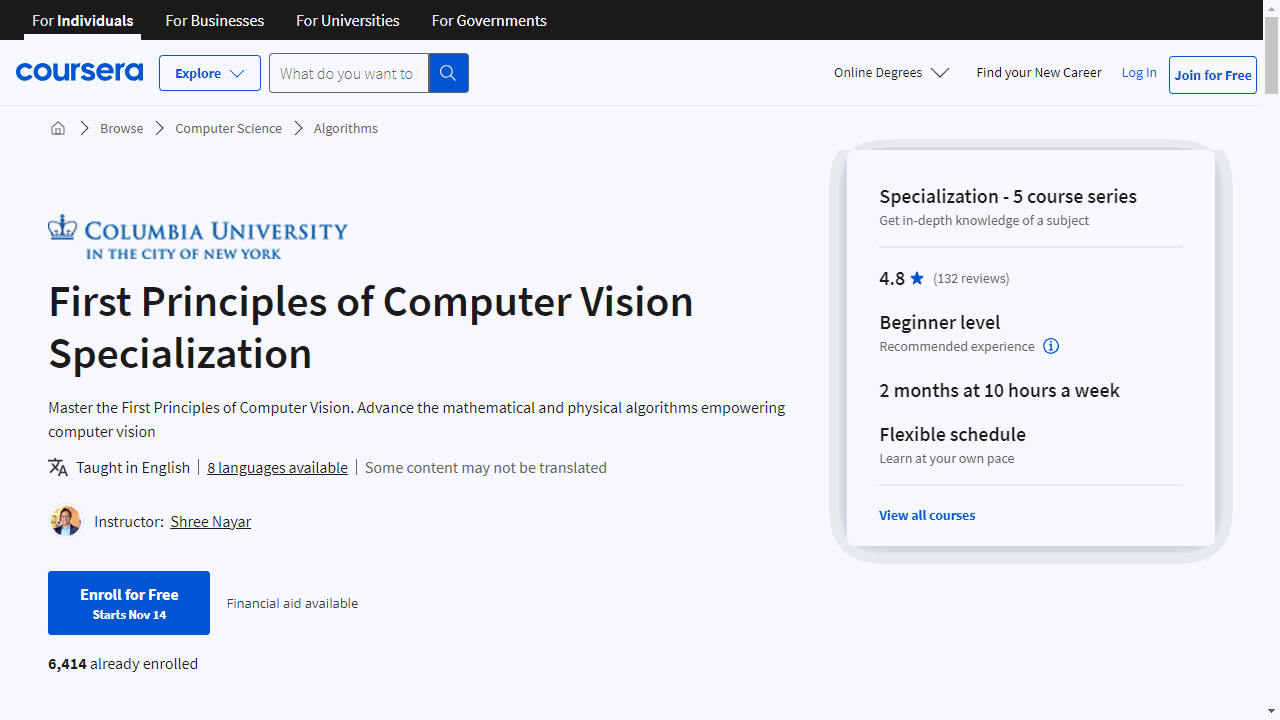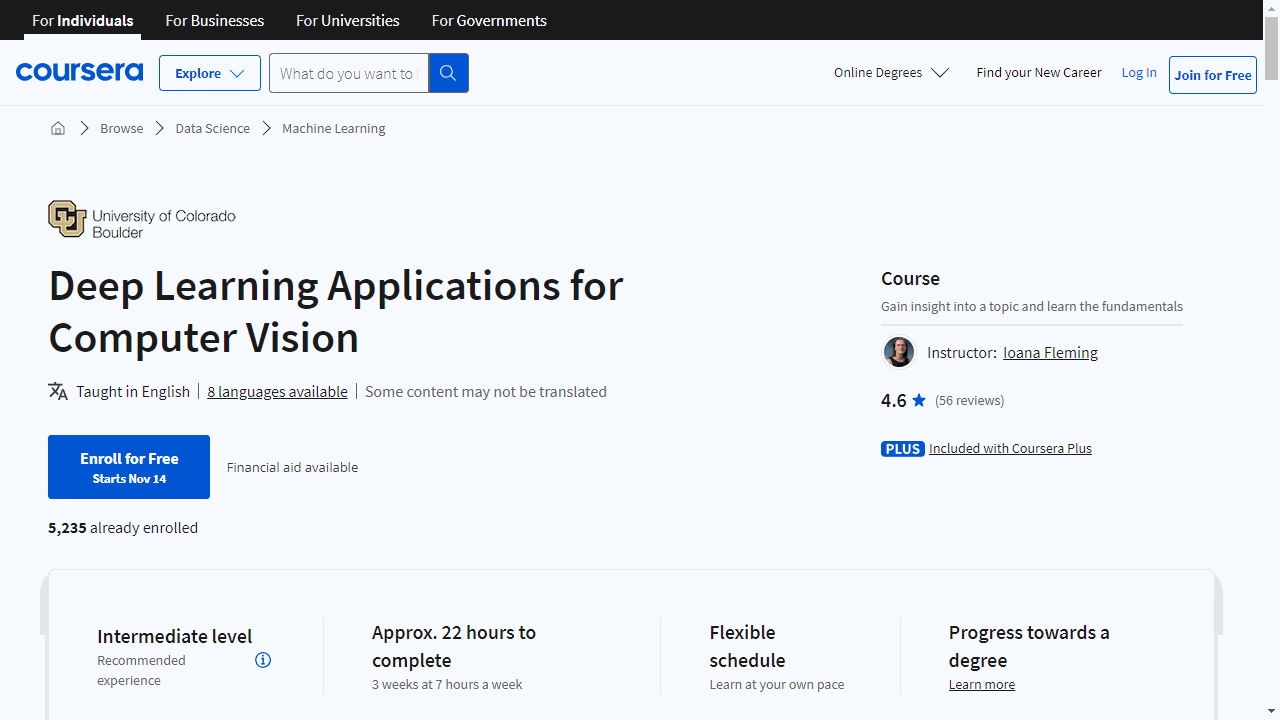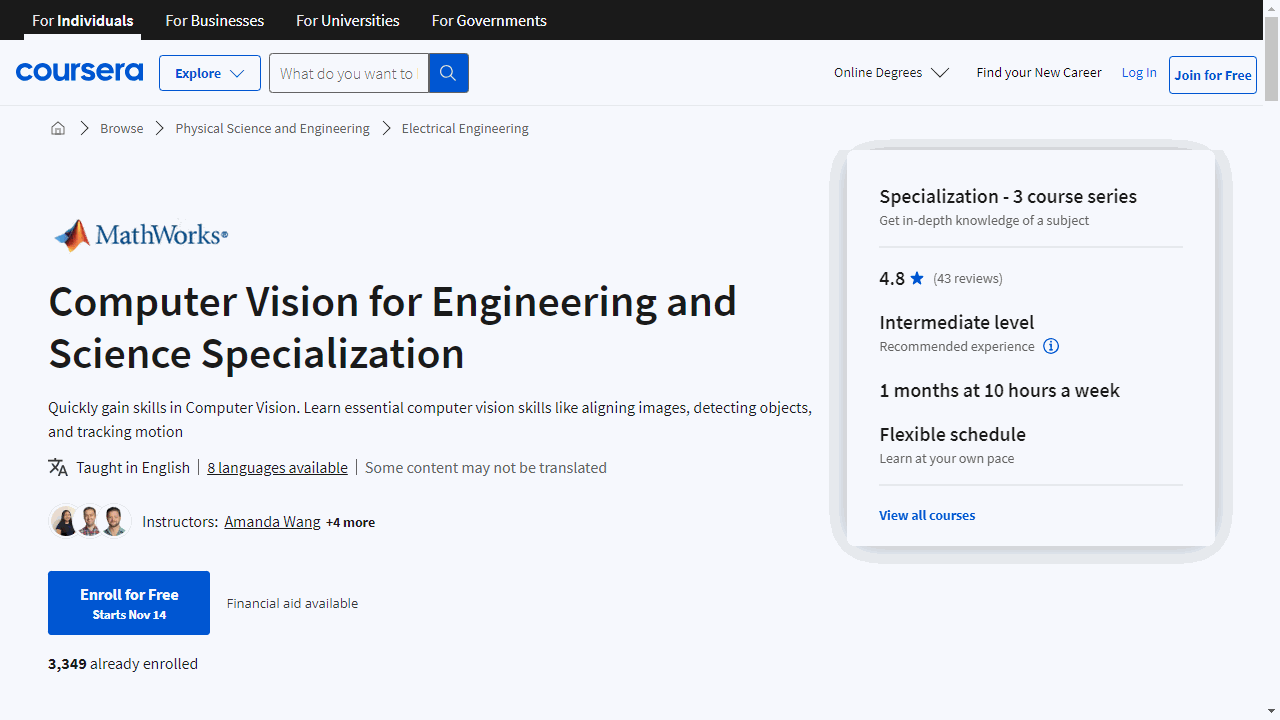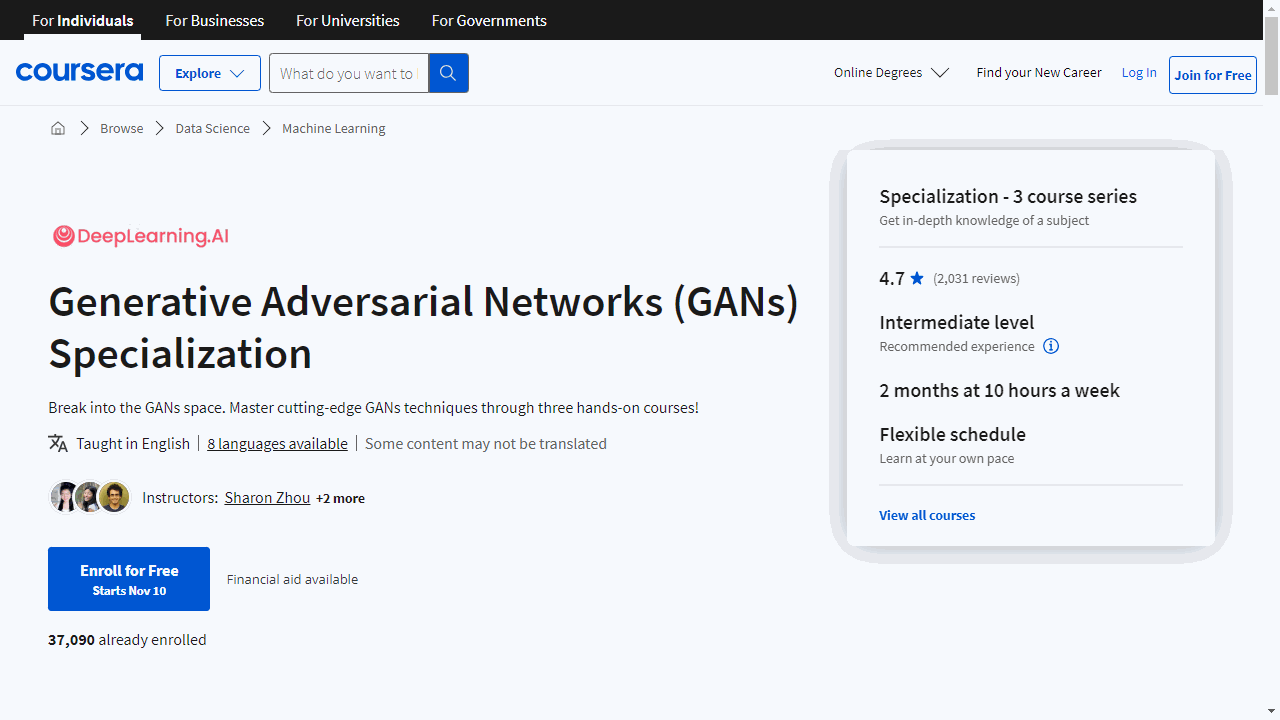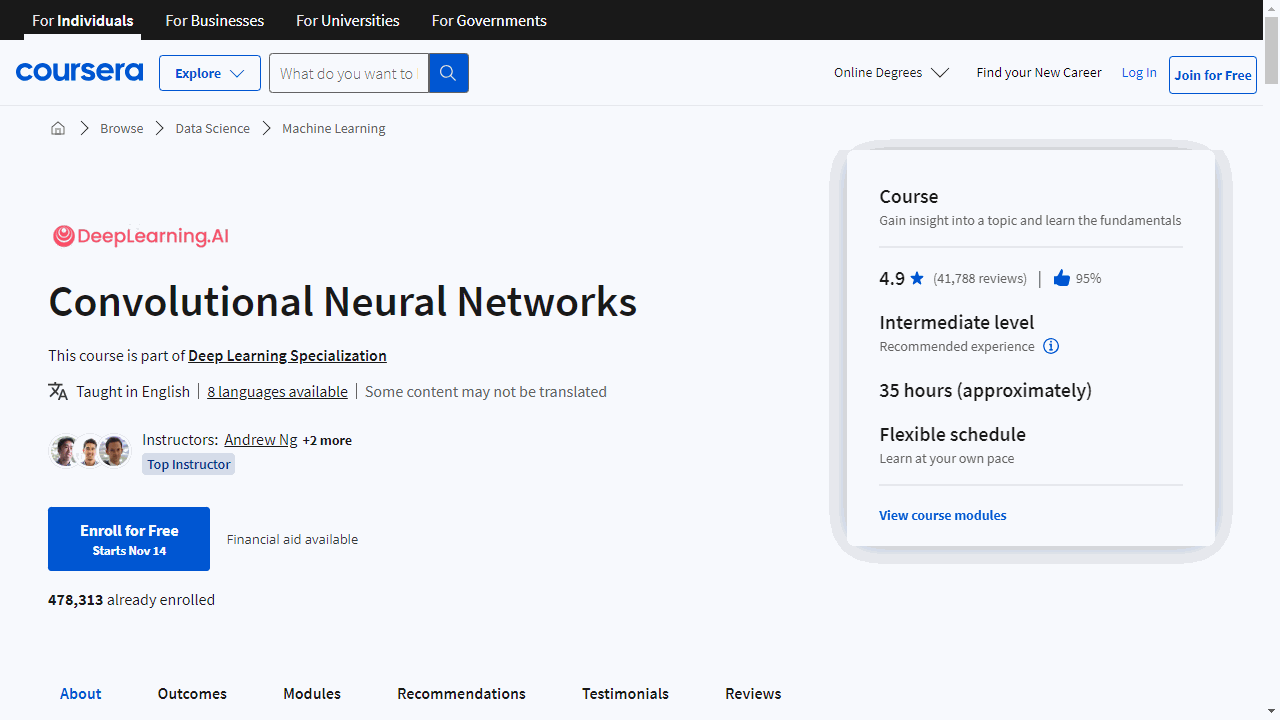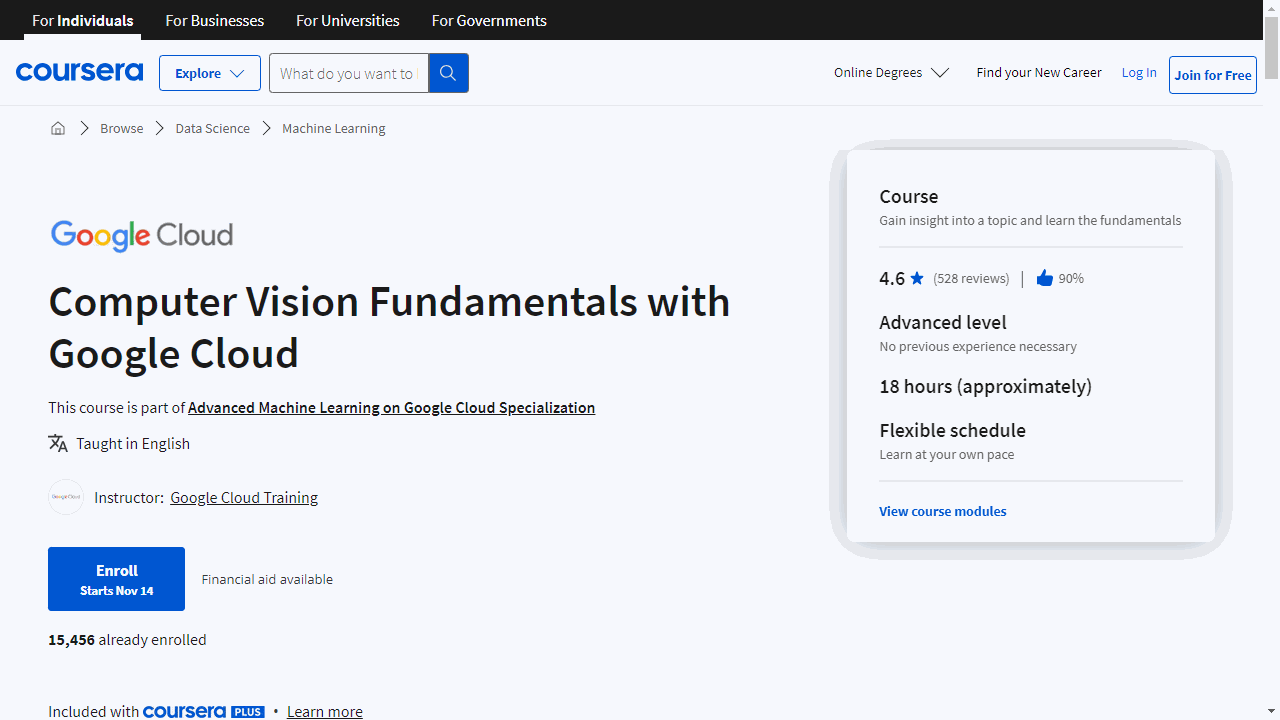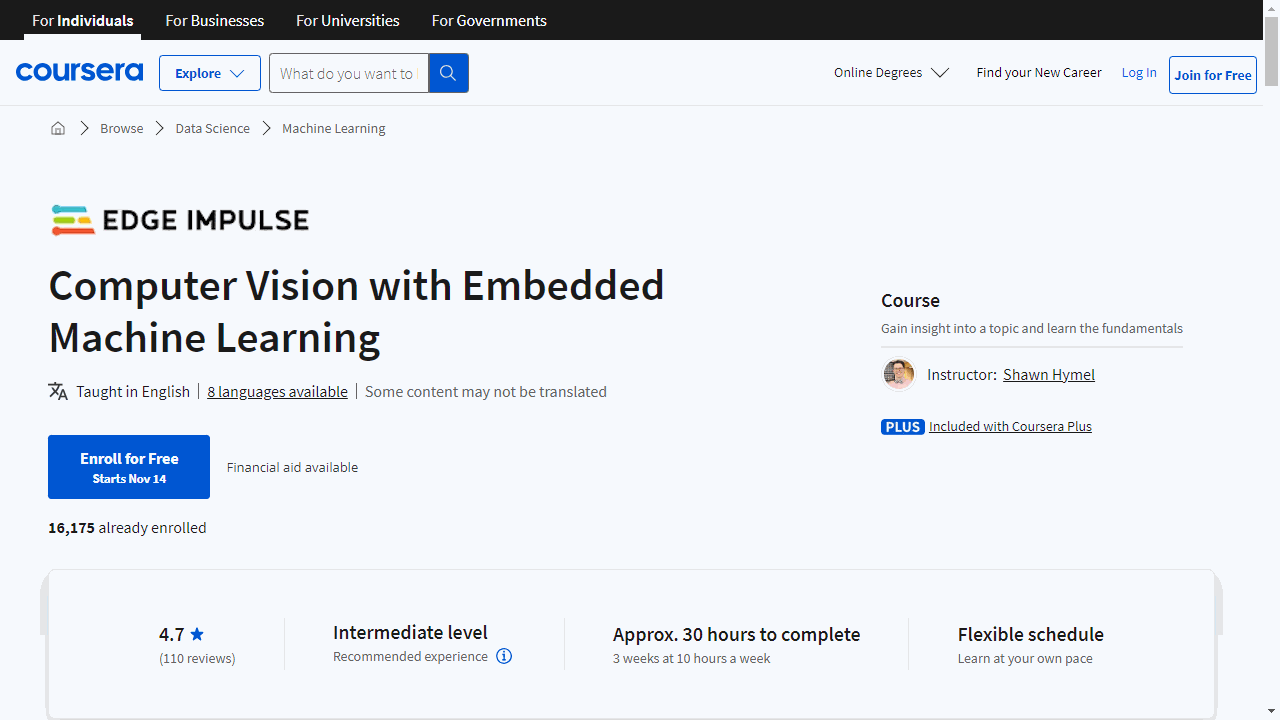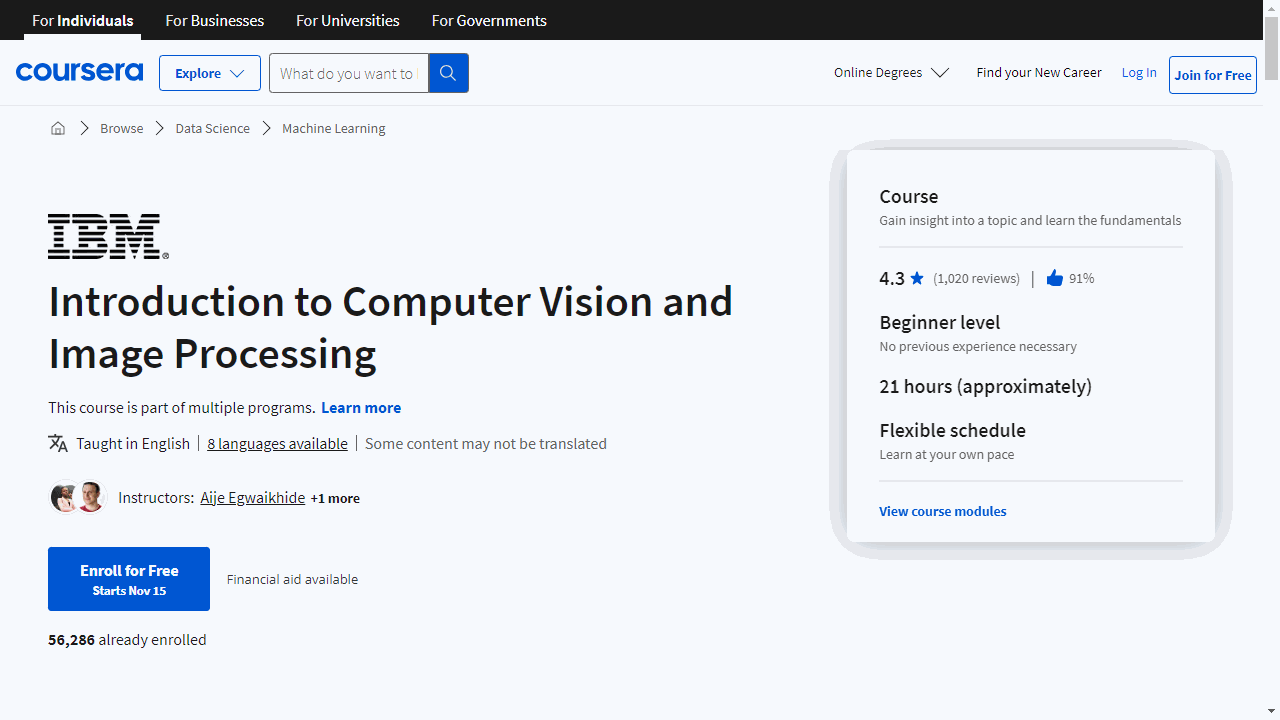Computer vision is a rapidly growing field that empowers computers to “see” and “understand” the world around them, much like humans do.
This ability to analyze images and videos has revolutionized various industries, from healthcare and manufacturing to autonomous vehicles and security systems.
By learning computer vision, you can gain the skills to develop cutting-edge applications, automate tasks, and contribute to exciting advancements in AI and robotics.
Finding a comprehensive and engaging computer vision course on Coursera can be a challenging task, with numerous options vying for your attention.
You’re seeking a program that delves into the core concepts, provides practical experience, and equips you with the knowledge to apply your skills in real-world scenarios.
For the best computer vision course overall on Coursera, we recommend “First Principles of Computer Vision Specialization” by Columbia University.
This meticulously crafted program goes beyond mere theory, guiding you through the fundamental concepts and practical applications of computer vision.
From the intricacies of camera and imaging to the complexities of 3D reconstruction and visual perception, this specialization offers a comprehensive and engaging learning experience.
While this program stands out as our top choice, there are other excellent computer vision courses available on Coursera.
Keep reading to discover more recommendations tailored to specific learning levels, career goals, and areas of specialization within computer vision.
First Principles of Computer Vision Specialization
This suite of courses is meticulously designed to guide you through the essentials of computer vision, ensuring you grasp both the theoretical underpinnings and practical applications.
The journey begins with “Camera and Imaging,” where you’ll unravel the intricacies of how images are captured and processed.
You’ll delve into the workings of image sensors and learn the principles of designing cameras for capturing images in high dynamic range.
The course also equips you with the tools for basic image processing, setting the stage for more advanced exploration.
Moving on to “Features and Boundaries,” you’ll develop the skills to identify key elements within images, such as edges and corners—essential for interpreting and analyzing visual data.
The course introduces you to techniques like active contours and the Hough Transform, enabling you to extract and manipulate features with precision.
In “3D Reconstruction - Single Viewpoint,” the focus shifts to extracting three-dimensional information from two-dimensional representations.
You’ll explore methods like photometric stereo, which reveals the texture and shape of objects, enriching your understanding of how light interacts with surfaces to create the images we see.
The “3D Reconstruction - Multiple Viewpoints” course expands your perspective, teaching you to integrate information from multiple angles to build comprehensive 3D models.
You’ll learn about camera calibration and stereo vision, gaining insights into how these techniques are applied in fields such as robotics and virtual reality.
Lastly, “Visual Perception” addresses the challenge of interpreting and understanding visual data.
This course covers object tracking, image segmentation, and object recognition, culminating in the use of neural networks for classifying and identifying objects.
It’s a deep dive into the cognitive aspects of computer vision, mirroring the way humans perceive and make sense of visual information.
Whether you’re aiming to advance in your career or simply passionate about the field, these courses provide a valuable and enriching learning experience.
Deep Learning Applications for Computer Vision
With a well-structured syllabus spanning 19 lectures, it offers a deep dive into the intersection of deep learning and image recognition.
The course begins by laying a solid foundation in the principles of computer vision and deep learning.
This ensures that you have a clear understanding of the core concepts before progressing to more complex topics.
As you progress, the course introduces neural networks, the powerhouse behind image recognition.
You’ll learn how these networks mimic the human brain to interpret visual data, a fascinating process that’s at the forefront of technological innovation.
Lecture 10, a three-part series within the course, delves into specific techniques and tools that enhance a computer’s ability to process and understand visual data.
You’ll explore sophisticated topics such as object recognition, facial recognition, and even emotion detection, all of which are highly relevant in today’s tech landscape.
Computer Vision for Engineering and Science Specialization
The journey begins with “Introduction to Computer Vision,” where you’ll grasp the basics of how computers interpret visual data.
You’ll delve into algorithms that allow you to align and stitch images, a skill that’s invaluable for creating detailed panoramic images or analyzing satellite data.
Image registration, a critical component for comparing and combining images, is also covered in depth.
The course is hands-on, with MATLAB as the primary tool, ensuring you’re learning with software that’s respected in the engineering and science fields.
Moving on to “Machine Learning for Computer Vision,” you’ll explore the intersection of computer vision and machine learning.
This course empowers you to train models for image classification and object detection, applying these skills to practical scenarios like identifying street signs or spotting manufacturing defects.
The course emphasizes the machine learning workflow, from data preparation to model evaluation, reinforcing your learning with real-world applications.
The final course, “Object Tracking and Motion Detection with Computer Vision,” teaches you to track objects and detect motion within video streams.
Using pre-trained deep neural networks and optical flow, you’ll learn to analyze video data, a skill set that’s increasingly relevant in today’s tech landscape.
The capstone project simulates a real-world challenge, asking you to track and count vehicles on a highway, providing a tangible demonstration of your newly acquired skills.
While some prior experience in image processing is beneficial, beginners can first tackle the “Image Processing for Engineering and Science specialization” to prepare.
In summary, this specialization offers a structured and detailed exploration of computer vision, with MATLAB as a central learning tool.
Generative Adversarial Networks (GANs) Specialization
This series of courses is structured to guide you from the elementary principles to the more complex aspects of GANs in a coherent and practical way using Python.
Even though today diffusion models, like DALL-E, Midjourney, and Stable Diffusion, dominate the field of image generation, GANs are still used to improve the quality of the generated images.
Starting with “Build Basic Generative Adversarial Networks (GANs),” you’ll delve into the world of GANs, uncovering their potential to revolutionize image generation.
The course simplifies complex concepts, allowing you to grasp the mechanics behind GANs and to experiment with various architectures.
You’ll also tackle the creation of conditional GANs, which can generate images within specific categories.
Beyond the technical skills, the course addresses critical issues such as machine learning bias and privacy concerns.
Practical exercises with PyTorch will enable you to train and refine your own models, ensuring that you’re not just learning theory but also applying it.
Moving on to “Build Better Generative Adversarial Networks (GANs),” you’ll deepen your understanding by learning how to evaluate the performance of your GANs using methods like the Fréchet Inception Distance.
The course introduces you to StyleGANs, a sophisticated model known for generating highly realistic images.
Here, the focus is on refining your GANs for better output while continuing to consider the ethical implications of your work.
The final course, “Apply Generative Adversarial Networks (GANs),” shows you how GANs can solve practical problems.
You’ll explore applications beyond image generation, such as data augmentation and enhancing privacy.
Projects like Pix2Pix and CycleGAN will give you a taste of how GANs can transform images in innovative ways, such as altering satellite imagery or changing the appearance of animals in photographs.
Throughout the specialization, you’ll acquire a range of skills, from controllable generation to understanding convolutional neural networks.
TensorFlow: Advanced Techniques Specialization
This specialization is tailored for those with a foundational understanding of Python and TensorFlow, aiming to enhance their skills in building sophisticated machine learning models.
The course “Custom Models, Layers, and Loss Functions with TensorFlow” offers a deep dive into the intricacies of TensorFlow’s APIs.
You’ll learn to construct multi-output models, including Siamese networks, and delve into the creation of custom loss functions to fine-tune your model’s learning process.
The course also covers the development of custom layers and the implementation of your own model classes, empowering you to design a ResNet from the ground up.
In “Custom and Distributed Training with TensorFlow,” the focus shifts to gaining granular control over model training.
You’ll explore TensorFlow’s core components and learn to manage training loops manually for greater flexibility.
The course also introduces distributed training, a technique that accelerates the training process by leveraging multiple GPUs or TPUs, enabling you to handle larger datasets and more complex models efficiently.
“Advanced Computer Vision with TensorFlow” is the core of this specialization for computer vision enthusiasts.
It covers a broad range of topics, from image classification and segmentation to object localization and detection.
You’ll apply transfer learning to practical tasks and customize cutting-edge models.
The course also emphasizes model interpretability, teaching you to use class activation and saliency maps to understand and improve your model’s decision-making process.
Lastly, “Generative Deep Learning with TensorFlow” explores the creative side of machine learning.
You’ll experiment with neural style transfer, combining the aesthetics of famous artworks with your images.
The course guides you through building AutoEncoders for image denoising and introduces you to the fascinating world of VAEs and GANs, where you’ll learn to generate new, unique data, such as anime faces.
Convolutional Neural Networks
Convolutional Neural Networks are the cornerstone of machine learning for computer vision, and this course offers a deep dive into the mechanics and applications of this technology.
Starting with the fundamentals, you’ll explore edge detection, which is the cornerstone of how computers interpret visual data.
It’s like teaching a computer to understand the outlines and shapes that make up the world around us.
The course then smoothly transitions into more complex concepts such as padding and strided convolutions.
Padding ensures that the computer doesn’t miss out on information at the edges of an image, while strided convolutions help it analyze images more efficiently by skipping over pixels at regular intervals.
As you progress, you’ll construct a convolutional network layer by layer.
This hands-on approach solidifies your understanding of how these networks function and why they’re crucial for image recognition tasks.
Pooling layers are introduced as a method to help the network focus on the most relevant information, reducing the computational load and improving efficiency.
The curriculum also includes a valuable interview with Yann LeCun, a pioneer in the field of artificial intelligence, providing insights into the practical applications of these technologies.
You’ll then delve into the architecture of classic networks, ResNets, and how they solve common problems in deep learning.
The course explains these concepts in a clear and accessible manner, ensuring you grasp the reasons behind their effectiveness.
MobileNets and EfficientNet are covered as well, highlighting the latest advancements in creating fast and powerful networks suitable for devices with limited computational power.
Practical skills such as using open-source implementations, transfer learning, and data augmentation are taught, empowering you to leverage pre-existing resources and techniques to enhance your projects.
The latter part of the course addresses the current state of computer vision, covering essential topics like object localization, landmark detection, and object detection.
You’ll learn to implement the YOLO algorithm, which is renowned for its speed and accuracy in real-time object recognition.
The course concludes with advanced topics such as face recognition and neural style transfer, where you’ll understand how to apply these networks to create systems that can identify individuals or even replicate artistic styles.
Throughout the course, you’ll encounter practical challenges like non-max suppression and anchor boxes, which are critical for improving the accuracy of object detection models.
Fundamentals of Digital Image and Video Processing
Offered by Northwestern University, this course begins by clarifying the distinction between analog and digital signals, setting the stage for a deeper understanding of image and video technology.
You’ll explore how these signals are represented within the electromagnetic spectrum, which is essential for grasping how images are captured and displayed.
As you progress, the course introduces you to discrete signals in both two and three dimensions, as well as complex exponential signals.
These concepts might seem complex at first, but they’re fundamental to digital image processing and are presented in an accessible way.
Key to image enhancement, you’ll learn about linear shift-invariant systems and 2D convolution.
The course doesn’t just stop there; it also teaches you filtering techniques in both the spatial and frequency domains, allowing you to manipulate images to improve clarity or alter their appearance.
Sampling and the Discrete Fourier Transform are also covered, providing you with the knowledge to handle digital images while maintaining their quality.
You’ll also learn about changing sampling rates, which is crucial when working with various image sizes and resolutions.
The course then takes you through motion estimation, where you’ll encounter phase correlation and block matching—techniques that are the backbone of video processing and tracking movement.
When it comes to color image processing, the course offers a progression from introductory concepts to more sophisticated techniques like histogram processing, noise smoothing, and sharpening.
You’ll also delve into homomorphic filtering and pseudo coloring, which can dramatically enhance the visual impact of images.
In the realm of video enhancement and image restoration, the course equips you with the skills to recover and enhance images that may seem degraded.
You’ll become familiar with matrix-vector notation for images and various restoration algorithms, including iterative and adaptive methods.
Compression is another critical topic covered in the course.
You’ll learn about the mechanics behind making files more manageable for sharing and storage, including an understanding of coding techniques and standards like JPEG and MPEG.
Finally, the course introduces advanced methods such as sparsity-promoting norms and matching pursuit.
These techniques are at the forefront of image processing and can be applied to a range of practical scenarios.
Computer Vision Fundamentals with Google Cloud
This course is designed to give you a comprehensive understanding of computer vision, coupled with practical experience using Google Cloud’s tools.
The course begins with the basics, explaining what computer vision is and the various problems it can solve.
You’ll see how it’s applied in the real world, which will help you grasp the potential of this technology.
Then, you’ll dive into the Vision API, where you’ll learn to detect various elements in images.
This is your first step in teaching a computer to “see.”
As you progress, the course introduces you to the Google Cloud Platform and Qwiklabs, where you’ll extract text from images, a skill with countless applications.
Vertex AI comes next, a platform that simplifies the machine learning workflow.
You’ll understand why a unified platform is crucial as you tackle a project identifying car part damage using Vertex AI.
The course doesn’t stop there.
It delves into the technicalities of linear models and neural networks, essential concepts for image classification.
You’ll get hands-on experience building and implementing these models, gaining insights into their structure and function.
When it comes to Convolutional Neural Networks (CNNs), the course offers a deep dive.
You’ll learn about the mechanics of convolutions, model parameters, and the role of pooling layers.
Implementing CNNs on Vertex AI with a TensorFlow container will give you a practical understanding of these networks.
Data handling is also a key focus.
You’ll explore image data preprocessing, learn how to combat the challenge of limited data, and employ data augmentation to enhance your models.
The course wraps up with transfer learning, teaching you how to leverage pre-existing models to save time and improve performance.
Throughout the course, the labs provide a hands-on approach to learning, ensuring that you’re not just passively absorbing information but actively applying it.
By the end, you’ll have a solid foundation in computer vision and the skills to apply this technology using Google Cloud’s powerful tools.
Computer Vision with Embedded Machine Learning
It’s getting more and more common to see machine learning models deployed on devices with limited computational power, such as smartphones and IoT devices.
This course is designed to tackle the specific challenges of deploying computer vision models on these devices.
The course kicks off with an introduction to the world of computer vision, starting with the essentials of digital images and data collection.
This foundational knowledge is crucial for what comes next.
You’ll then delve into image classifiers, learning the mechanics behind teaching computers to differentiate between various objects.
The course doesn’t just throw jargon at you; it provides hands-on experience with neural networks using accessible tools like Keras and Google Colab.
As you progress, you’ll work with Edge Impulse for model training, and you’ll apply your skills to both single board computers and microcontrollers.
This is where you see the real-world applications of your work.
The curriculum then deepens your understanding with modules on image convolution, pooling layers, and CNNs.
These concepts are the building blocks of advanced computer vision, and you’ll have the opportunity to visualize what your CNN is learning, which is a powerful way to grasp the intricacies of your models.
The course also covers data augmentation and transfer learning, teaching you how to enhance your models’ performance efficiently.
You’ll explore MobileNet, a tool that streamlines the process of implementing powerful vision models on mobile devices.
When it comes to object detection, the course ensures you’re well-versed in evaluating model performance and introduces you to a variety of object detection models.
You’ll even get to deploy your own model to a single board computer.
In the latter stages, you’ll tackle image segmentation and multi-stage inference, learning from industry experts who share their insights on leveraging existing model representations for new tasks.
By the end of this course, you’ll have a robust set of skills in computer vision and embedded machine learning.
The curriculum is designed to be accessible yet challenging, ensuring that you’re equipped to build and deploy your own models.
Introduction to Computer Vision and Image Processing
The course, offered by IBM, begins with an overview of computer vision, setting the stage for its numerous applications.
Understanding digital images is crucial, and this course breaks it down for you.
You’ll learn the nuts and bolts of image manipulation, starting with individual pixels and advancing to more complex transformations.
This isn’t just about theory; you’ll apply what you learn through hands-on exercises using OpenCV that demonstrate how image filters and adjustments work.
As you progress, the course introduces you to image classification.
You’ll start with simple techniques like KNN and advance to more sophisticated methods, including linear classifiers and logistic regression.
The concept of gradient descent is demystified, showing you how algorithms can improve their accuracy over time.
Neural networks are at the heart of modern computer vision, and you’ll delve into the architecture of fully connected networks before exploring the power of Convolutional Neural Networks (CNNs).
These sessions are designed to give you a clear understanding of how machines interpret visual data.
Finally, the course covers object detection, teaching you to use tools like Haar Cascade Classifiers, which are used for face detection too.
This section is particularly engaging, as it translates complex algorithms into practical skills you can apply immediately.
Also check our posts on:
